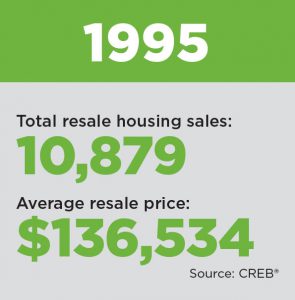
Aug. 23, 2016 | Cailynn Klingbeil
55 years of Calgary Real Estate: 1995 CREB® President Wayne McAlister
Despite a challenging year, 1995 CREB® president Wayne McAlister chose to focus on the silver liningsA self-described "eternal optimist," Wayne McAlister still couldn't be blamed for looking back at 1995 with some degree of pessimism.
After all, as CREB®'s president that year, he oversaw Calgary's housing industry at a time when employment uncertainty had waned for years, resulting in weak consumer confidence and a painfully slow market.
"There was a downturn in the early '90s, with oil down – dramatically low – and the whole economy was feeling the pinch," he said. "(By 1995), we were still experiencing an economic downturn. There was some good, some bad that year."
As evidenced by CREB® statistics that year. Sales in 1995 were still off by 25 per cent from two years earlier, yet the average price had already rebounded to $136,534
"It was gloomy," McAlister remembers. "Not desperate, but certainly gloomy."
Ever the optimist, McAlister also noted there was hope on the horizon that year in the form of jobs.

"CP Rail announced they were moving here," he said, also noting Suncor and Shaw Communications' decisions to move their respective head offices to Calgary that year helped offset the pending loss of Canadian Airlines' heavy maintenance operations to Vancouver in 1996.
McAlister said many in Calgary in 1995 saw the announcement that Canadian Pacific Railway's headquarters were moving from Montreal to Calgary as a sign of a shift in power westward. For REALTORS®, it was an impending opportunity: the hundreds of staff transferring to Calgary the following year needed homes.
Amid that atmosphere, the real estate industry itself was undergoing various transitions. The following year, the real estate industry in Alberta became fully sell-regulated with the creation of a new regulating body, the Real Estate Council of Alberta (RECA). Previously, the provincial government's Municipal Affairs Bureau oversaw the industry.
"The real estate industry lobbied for, and was approved for, self-regulation," said McAlister, noting, in 1995, preparation for the changes were underway, including selecting candidates for a new council.
CREB® also established a commercial division in 1995, adding extra courses and education for REALTORS® who specialized in commercial real estate.
And the MLS® System continued to evolve, including how the system was funded and the medium it appeared in. Previously, the board only received payment if the listed property sold. That year, a new system was adopted in which fees were charged for every listing that came on, no matter the end outcome.
"It was a significant change in what had been happening, and it created a more stable funding method," McAlister said.
For buyers, the house hunting experience also changed in 1995 when residential resale listings were moved online. Calgary and three other Canadian cities took part in a pilot project to test out Internet listings that year. Buyers, located anywhere in the world, could now log on to a computer and see pictures and a description of houses for sale.
The Internet's rising prominence was accompanied with plenty of concerns, recalled McAlister.
"It was fear of the unknown," he said. "There was great concern going to an Internet-based system would be the demise of the MLS®. That proved not to be accurate.
"Technology became our friend, but there was lots of apprehension."
In fact, like many CREB® presidents before and after him, McAlister considers technology as the biggest change he's seen in the real estate industry during his career.
"Buyers are demanding and receiving more information electronically," he said. "They're also using technology to do pre-scouting on their own, getting a good idea of the property from Google maps."
While beneficial in creating more informed buyers, it has also threatened what first attracted McAllister to the industry: the personal relationships.
McAlister entered real estate in 1978 after 12 years in the homebuilding industry. His background in building gave him expertise other REALTORS® didn't have, from nuances of how houses are built to design advantages and disadvantages.
"I could help people understand things about houses because of my construction background," he said.
"I liked the opportunity to interact with people in a positive way – helping people make a decision on likely the largest single financial decision of their life. You shouldn't be blasé about that. You should have empathy for the buyers or sellers."
McAllister added, "real estate is a business with lots and lots of personality. It used to be person-to-person transactions, but now you do business with people you've never seen."
While McAlister has seen the city grow "exponentially," some things have remained the same. For example, he noted the cost of housing in Calgary still tends to be higher than some other parts of Canada.
"That's driven primarily because of the oil industry, and people coming here for jobs and needing houses. That's put pressure on builders and upped the cost," McAlister said. "That's still the case. We go through cycles.
"There's cycle here, there's no doubt about it, but overall the outcome is the average price generally increases over time."
Tagged: 55 years of calgary real estate | average price | Calgary Real Estate | Calgary Real Estate News | Commercial | CREB presidents | CREB® | Economy | employment | Energy | MLS® System | past presidents | REALTORS | sales | Technology | Uncategorized | YYCRE




